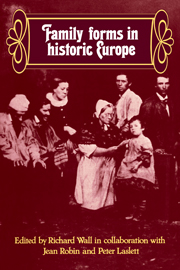Book contents
- Frontmatter
- Contents
- List of contributors
- Preface
- 1 Introduction
- 2 Two kinds of pre-industrial household formation system
- 3 ‘A large family: the peasant's greatest wealth’: serf households in Mishino, Russia, 1814–1858
- 4 The peasant family as an economic unit in the Polish feudal economy of the eighteenth century
- 5 The familial contexts of early childhood in Baltic serf society
- 6 Estonian households in the seventeenth and eighteenth centuries
- 7 Family and familia in early-medieval Bavaria
- 8 The property and kin relationships of retired farmers in northern and central Europe
- 9 Pre-industrial household structure in Hungary
- 10 The reconstruction of the family life course: theoretical problems and empirical results
- 11 The changing household: Austrian household structure from the seventeenth to the early twentieth century
- 12 Does owning real property influence the form of the household? An example from rural West Flanders
- 13 The evolving household: the case of Lampernisse, West Flanders
- 14 The composition of households in a population of 6 men to 10 women: south-east Bruges in 1814
- 15 The importance of women in an urban environment: the example of the Rheims household at the beginning of the Industrial Revolution
- 16 The household: demographic and economic change in England, 1650–1970
- 17 Family and household as work group and kin group: areas of traditional Europe compared
- References
- Index
14 - The composition of households in a population of 6 men to 10 women: south-east Bruges in 1814
Published online by Cambridge University Press: 05 November 2011
- Frontmatter
- Contents
- List of contributors
- Preface
- 1 Introduction
- 2 Two kinds of pre-industrial household formation system
- 3 ‘A large family: the peasant's greatest wealth’: serf households in Mishino, Russia, 1814–1858
- 4 The peasant family as an economic unit in the Polish feudal economy of the eighteenth century
- 5 The familial contexts of early childhood in Baltic serf society
- 6 Estonian households in the seventeenth and eighteenth centuries
- 7 Family and familia in early-medieval Bavaria
- 8 The property and kin relationships of retired farmers in northern and central Europe
- 9 Pre-industrial household structure in Hungary
- 10 The reconstruction of the family life course: theoretical problems and empirical results
- 11 The changing household: Austrian household structure from the seventeenth to the early twentieth century
- 12 Does owning real property influence the form of the household? An example from rural West Flanders
- 13 The evolving household: the case of Lampernisse, West Flanders
- 14 The composition of households in a population of 6 men to 10 women: south-east Bruges in 1814
- 15 The importance of women in an urban environment: the example of the Rheims household at the beginning of the Industrial Revolution
- 16 The household: demographic and economic change in England, 1650–1970
- 17 Family and household as work group and kin group: areas of traditional Europe compared
- References
- Index
Summary
Introduction
Cities by their very size pose considerable problems for those who wish to understand their social structure. The present study involves a detailed examination of the household and familial patterns of the inhabitants of the south-east sector of Bruges at the end of the Napoleonic period. Bruges was chosen because it is known to have exhibited an extreme imbalance between the sexes, a situation that the Napoleonic Wars had only served to intensify. Yet although women heavily outnumbered men, such a situation was not at all uncommon in European cities. In some cases this was the product of the flooding in of domestic servants to serve in the households of wealthier masters. In others it was associated with a particularly important textile industry – in the case of Bruges, lacemaking. Yet although this occupation had co-existed with the surplus of women in Bruges over a long period, it would be precipitate to assume that lacemaking was the sole or even the principal cause of the city's population structure. As will be pointed out later, the case for direct movement into Bruges of women seeking employment as lacemakers is very difficult to establish.
Bruges's tradition of lacemaking can be said to be world-famous, but surprisingly little is known of the family circumstances of those who were engaged in this production. Lacemaking qualifies as one of those activities which have in recent years come to be termed ‘protoindustrial’.
- Type
- Chapter
- Information
- Family Forms in Historic Europe , pp. 421 - 474Publisher: Cambridge University PressPrint publication year: 1983
- 8
- Cited by

